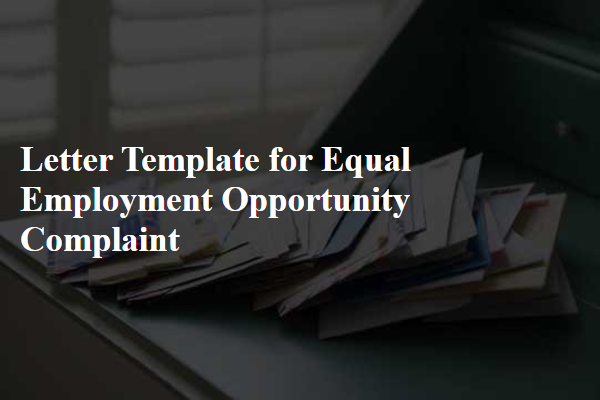If you've ever felt that your workplace could do better when it comes to equality and fairness, you're not alone. Addressing concerns about equal employment opportunities is crucial, not just for individual well-being but for fostering a more inclusive work culture. In this article, we'll explore how to effectively communicate your experiences through a complaint letter, ensuring your voice is heard and respected. So, let's dive in and discover how you can advocate for your rights and contribute to positive change in your workplace!

Clearly stated objective and request for resolution.
The Equal Employment Opportunity (EEO) complaint addresses the need for a fair workplace environment, highlighting discrimination based on protected characteristics such as race, gender, age, disability, or religion. The objective seeks a thorough investigation into the incidents that have occurred in the workplace setting, detailing specific events or actions taken by individuals or management. For resolution, the request emphasizes implementing appropriate corrective measures, such as training for employees on diversity and inclusion, policy re-evaluation, or general accountability procedures. This ensures a commitment to creating an equitable work environment for all employees, enhancing overall workplace culture and adherence to EEO laws.
Detailed description of incidents and facts.
The Equal Employment Opportunity complaint stems from a series of discriminatory incidents occurring at the corporate offices of XYZ Corporation, located in Austin, Texas, from January to March 2023. An employee, Jane Doe, faced repeated instances of unfair treatment due to her gender, which created a hostile work environment. On January 15, 2023, during a team meeting, her input was disregarded by a senior manager, John Smith, who then assigned her tasks to male colleagues, seemingly undermining her professional contributions. On February 10, 2023, when Jane sought clarification on a project, she was dismissed and told to "ask more qualified team members," indicating a lack of respect for her expertise as a marketing analyst with five years of experience. On March 5, 2023, a company-sponsored social event led to further exclusion, as Jane, the only female in her project group, was not invited to a critical team strategy session, where male colleagues openly discussed ideas without her participation. These events fostered an environment of inequality and disrespect, violating her rights and leading to psychological distress. Jane is seeking appropriate action to address these injustices and ensure a fair, inclusive workplace for all employees.
Reference to company policies and legal frameworks.
An equal employment opportunity complaint may arise when an employee or job applicant believes they have been subjected to discrimination based on race, gender, age, disability, or other protected characteristics as outlined in Title VII of the Civil Rights Act of 1964 and the Americans with Disabilities Act. Sections of company policies often reflect commitment to an inclusive workplace, prohibiting any discriminatory practices during hiring, promotion, or training processes. For example, a company may have a dedicated Equal Employment Opportunity (EEO) coordinator responsible for investigating complaints, adhering to guidelines set by the Equal Employment Opportunity Commission (EEOC). Legal frameworks encourage individuals to report grievances promptly, commonly within 180 days from the alleged discriminatory act, ensuring all claims are investigated thoroughly without retaliation. The importance of documentation, maintaining records of incidents such as harassment or bias during evaluations, is critical for building a strong case around grievances against employers.
Evidence supporting claims (e.g., emails, witness statements).
An Equal Employment Opportunity (EEO) complaint often involves significant evidence to substantiate claims of discrimination or unfair treatment in the workplace. To strengthen such complaints, critical pieces of evidence may include emails that reveal discriminatory language or practices, showcasing a pattern of bias against a specific group. Witness statements from colleagues can provide firsthand accounts of incidents that illustrate a hostile work environment or unequal treatment based on race, gender, or other protected characteristics. Documentation of performance evaluations may highlight discrepancies in feedback depending on an employee's demographic background. Collectively, these elements present a detailed narrative that can aid in the investigation of the complaint and reinforce the allegations of unfair employment practices.
Contact information and request for confidentiality.
Equal Employment Opportunity (EEO) complaints require careful presentation of specific details. Include the complainant's contact information, such as full name, address, phone number, and email address. In this section, clearly state the request for confidentiality, emphasizing the importance of privacy in sensitive matters related to discrimination, harassment, or retaliation. Mention relevant laws, such as Title VII of the Civil Rights Act of 1964, which protects employees from discrimination based on race, color, religion, sex, or national origin. Highlight any specific incidents, dates, and locations relevant to the complaint, ensuring a clear understanding of the context of the grievance. Such details assist the investigating entity in addressing the concerns effectively while maintaining the integrity of the complaint process.













Comments